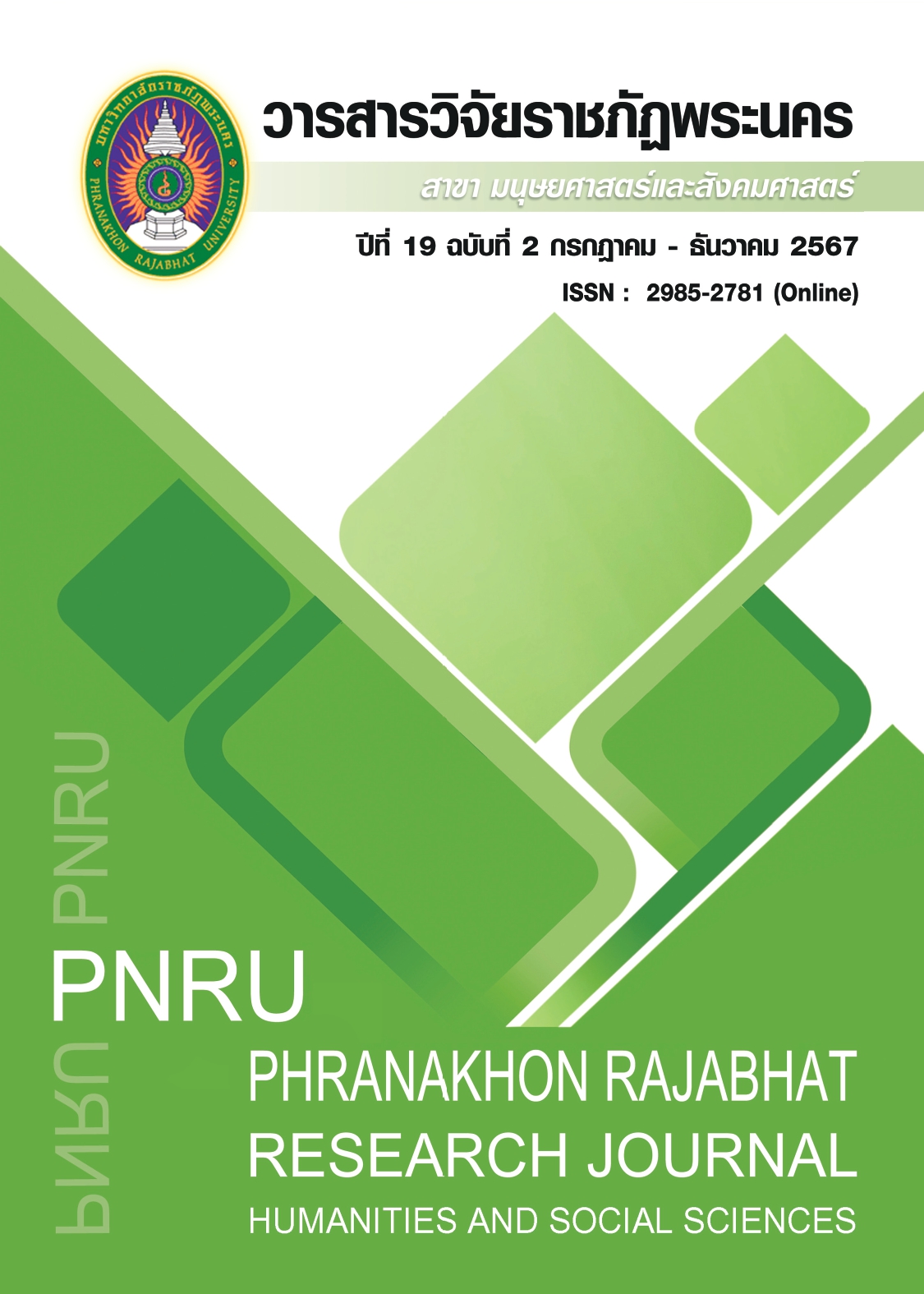STRATEGIC INNOVATION MANAGEMENT FOR TRANSITIONING GAS STATIONS TO THE ERA OF ELECTRIC VEHICLES
Main Article Content
Abstract
This research aimed to study strategic management in the transition of gas stations to the electric vehicle era in Thailand. The objectives were to analyze the management conditions and environment of gas stations during this transition and to design strategic management innovations. Data were collected from nine provinces in the northern region of Thailand. The research employed a qualitative approach, gathering data through semi-structured in-depth interviews. The study found that government policies significantly influenced the adoption of electric vehicles and the development of supporting infrastructure. The research proposed six key strategies, including service and infrastructure development, partnership and collaboration building, technology and personnel development, leveraging experience and location, adaptation and marketing, and risk and security management, along with 12 sub-strategies. These strategies aim to help gas stations adapt to a changing market and new technologies. Key strategies included diversifying services, investing in electric infrastructure, reducing dependence on oil revenue, and expanding services to meet new demands. Furthermore, the research emphasized building partnerships and collaborations with suppliers and stakeholders. The strategic management framework developed in this study provided comprehensive guidance for gas stations to adapt to changing market conditions and technological advancements. This research contributed practical information and actionable strategies for stakeholders in the energy sector. Future research should focus on long-term studies to assess the long-term impact of these strategies on business performance and sustainability.
Article Details

This work is licensed under a Creative Commons Attribution-NonCommercial-NoDerivatives 4.0 International License.
Each publish articles were copyright by Phranakorn Rajabhat University
Any contents which appeared in each articles in the journal were authors personal opinion. It did not relate to Phranakorn Rajabhat University and other instructors in the university. Each authors would take responsibility on their articles. If there are any mistake, the authors will take responsibility themselves
References
Aldouri, S. N. M., & Kumbhalkar, M. A. (2023). Use of Value Chain Analysis to Improve the Quality of Health Service. 3C Empresa, 12(1), 423-438.
Bertão, R. A., Jung, C. H., Chung, J., & Joo, J. (2023). Design thinking A customized blueprint to train R & D personnel in creative problem-solving. Thinking Skills and Creativity, 48, 101253.
Chayajirakit, Y. (2022). Strategic Management for New Generation Business Executives to Achieve Sustainable Success. MCU Loei Review Journal, 3(1), 151-159. (In Thai)
Christensen, C. M., Raynor, M. E., & McDonald, R. (2015). What Is Disruptive Innovation ?. Harvard Business Review, 93(12), 44-53.
Department of Energy Business, Ministry of Energy. (2023). List of oil entrepreneurs. Retrieved from https//www.doeb.go.th/info/info_operat_fuel.php. [2023, 1 Jul.] (In Thai)
Electric Vehicle Association of Thailand. (2023). Number of electric vehicle charging stations in Thailand. Retrieved from https//drive.google.com/file/d/1cPXOFPjDMchq179G5u
Hva9h2Y9Ek2M7/view. [2023, 1 Jul.] (In Thai)
Fernandez-Vidal, J., Gonzalez, R., Gasco, J., & Llopis, J. (2022). Digitalization and corporate transformation: The case of European oil & gas firms. Technological Forecasting and Social Change, 174, 121293.
Hitt, M. A., Ireland, R. D., & Hoskisson, R. E. (2020). Strategic Management Concepts and Cases Competitiveness and Globalization. Cengage Learning.
Jongwannasiri, S. (2019). Innovative Organization Book of Knowledge. Retrieved from https//ifi.nia.or.th/wp-content/uploads/2020/09/Innovative-Organization-BOK_digital_
-2020.pdf. [2023, 1 Jul.] (In Thai)
Kasongo, J., Begolli, A., Haider, D., & Zhang, J. (2019). The Use of a Blue Ocean Marketing Strategy for Market Capture in the US A Case Study of the Blujade Company. Available at SSRN 3861024.
Kim, W. C., & Mauborgne, R. A. (2017). Blue Ocean Strategy. Harvard Business Review Press.
Kusmulyono, M. S., Rachman, R. A., & Gunawan, V. P. (2023). Five Forces Analysis of Coffee Business Industry in Temanggung Regency of Central Java. Maker Jurnal Manajemen, 9(1), 76-89.
Liedtka, J. (2017). Evaluating the impact of design thinking in action. In Academy of Management Proceedings (Vol. 2017, No. 1, p. 10264). Briarcliff Manor, NY 10510: Academy of Management.
Lv, M. & Zhang, X. (2022). Research and Design of Future-oriented Smart Gas Station Service. In P.P., Rau (Ed.) Cross-Cultural Design. Product and Service Design, Mobility and Automotive Design, Cities, Urban Areas, and Intelligent Environments Design. HCII 2022. Lecture Notes in Computer Science, vol 13314. Switzerland: Springer.
Madaus, G. F., Scriven, M. S., & Stufflebeam, D. L. (1983). Evaluation models: Viewpoints on educational and human services evaluation. Netherlands: Kluwer-Nijhoff.
Olabi, A. G., Abdelkareem, M. A., Wilberforce, T., Alami, A. H., Alkhalidi, A., Hassan, M. M., & Sayed, E. T. (2023). Strength, weakness, opportunities, and threats (SWOT) analysis of fuel cells in electric vehicles. International Journal of Hydrogen Energy, 48(60), 23185-23211.
Podhisita, C. (2021). Science and art. Qualitative research. Bangkok: Amarin Printing. (In Thai)
Polsinthu-us, P. (2018). A study of the perspectives of gas station business operators on the electric charging station business. Nakhon Pathom, Mahidol University. (In Thai)
Porter, M. E. (2008). The Five Competitive Forces That Shape Strategy. Harvard Business Review, 86(1), 78-93.
Puyt, R. W., Lie, F. B., & Wilderom, C. P. (2023). The origins of SWOT analysis. Long Range Planning, 56(3), 102304.
Rane, S. B., & Narvel, Y. A. M. (2021). Re-designing the business organization using disruptive innovations based on blockchain-IoT integrated architecture for improving agility in future Industry 4.0. Benchmarking An International Journal, 28(5), 1883-1908.
Schmarzo, B. (2017, May 2). Can design thinking unleash organizational innovation? Retrieved from https//www.datasciencecentral.com/profiles/blogs/can-design-thinking-unleashorganizational-innovation. [2023, 1 Jun.]
Sirasunthorn, P., Rungsuriyawiboon, S., Opaspanyasan, R., and Wongcharoen, P. (2019). Project evaluation of measures to promote electric vehicle adoption on consumer acceptance and energy efficiency in the transport sector (Report No. RDG60D0003). Bangkok, Thailand: Office of the Science, Research, and Innovation Promotion Commission. (In Thai)
Burra, N. J., & Ushadevi, K. N. (2022). Porter’s Five Forces Analysis of Zanzibar’s Seaweed Industry. Asian Journal of Agricultural Extension, Economics & Sociology, 40(11), 185-196.
Wang, C., Guo, F., & Zhang, Q. (2023). How does disruptive innovation influence firm performance? A moderated mediation model. European Journal of Innovation Management, 26(3), 798-820.


